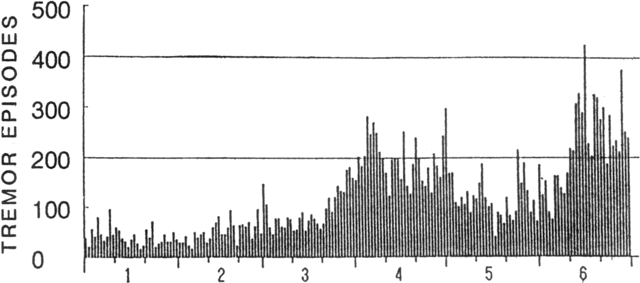Report on Asosan (Japan) — June 1989
Scientific Event Alert Network Bulletin, vol. 14, no. 6 (June 1989)
Managing Editor: Lindsay McClelland.
Asosan (Japan) Ash ejections continue; new vent on crater floor
Please cite this report as:
Global Volcanism Program, 1989. Report on Asosan (Japan) (McClelland, L., ed.). Scientific Event Alert Network Bulletin, 14:6. Smithsonian Institution. https://doi.org/10.5479/si.GVP.SEAN198906-282110
Asosan
Japan
32.8849°N, 131.085°E; summit elev. 1592 m
All times are local (unless otherwise noted)
After a small ash ejection 5 April, tephra emission continued at a relatively high rate in May and June. On 8 May at 1000, a vent (1 m in diameter) on the Naka-dake crater floor ejected ash to ~10 m. At 1132, an M 3.3 shock (3 on the JMA Intensity Scale) occurred beneath the crater and was felt at AWS. Five (felt) aftershocks were recorded on 8 May (at 1120, 1147, 1216, 1417, and 2039), and 1 (not felt) was recorded the next day (at 0057) by a seismograph 0.8 km W of the crater. A 1-km area around the crater was closed to tourists by the Aso Disaster Authority. During a field survey at 1910, no ash ejection was observed.
On 16 May, ash rose ~100 m above the crater rim at 0810, and ~200 m at 1030. About 20% of the crater floor was covered by a rainwater pool, from which mud and water were continuously ejected to 3 m. During a field survey on 20 May at 1150, a strong rumbling noise was audible, but no ash ejection was seen.
Ash rose ~200 m above the crater rim on 22 May from 0740 to 0800, and 20 m above the crater floor at 0820. Activity declined, stopping by 1000. Two days later at 1000, ash was ejected to 200 m above the crater rim, and 5 g/m2 of ash was deposited at AWS. Ash had not fallen there since 28 June 1985. Red glow at the vent and in cracks on the crater floor was observed at night through May. During the night of 27 May, red glow emanated from 40-50% of the crater floor. On 28 May, ash rose about 50 m from the N portion of the vent.
In June, a vent on the NW floor of Crater 1 emitted an ash-laden steam plume a few hundred meters above the crater rim. During a 6 June field survey, the vent had enlarged and was emitting a 300-m ash plume. Flames from burning volcanic gases were occasionally observed rising 3-4 m above the crater floor during night visits. Ash accumulation at AWS was 9 g/m2 on the 7th, and 2 g/m2 on the 8th. The Crater 1 vent was buried by ash during rainfall 8-9 June. A new vent (named "891") about 18 m in diameter opened in the center of the crater floor on 10 June, and was the largest new vent since "853" formed 6 May 1985. The highest plumes of the month reached 1,000 m above the crater rim on 7 and 20 June.
Isolated volcanic tremor remained high (200-400 events/day) in May and June (figure 11) with a total of 5,760 events in May and 6,752 in June (compared to 5,821 in April). The amplitude of continuous tremor was generally unchanged in May but increased slightly in June.
Geological Summary. The 24-km-wide Asosan caldera was formed during four major explosive eruptions from 300,000 to 90,000 years ago. These produced voluminous pyroclastic flows that covered much of Kyushu. The last of these, the Aso-4 eruption, produced more than 600 km3 of airfall tephra and pyroclastic-flow deposits. A group of 17 central cones was constructed in the middle of the caldera, one of which, Nakadake, is one of Japan's most active volcanoes. It was the location of Japan's first documented historical eruption in 553 CE. The Nakadake complex has remained active throughout the Holocene. Several other cones have been active during the Holocene, including the Kometsuka scoria cone as recently as about 210 CE. Historical eruptions have largely consisted of basaltic to basaltic andesite ash emission with periodic strombolian and phreatomagmatic activity. The summit crater of Nakadake is accessible by toll road and cable car, and is one of Kyushu's most popular tourist destinations.
Information Contacts: JMA.


